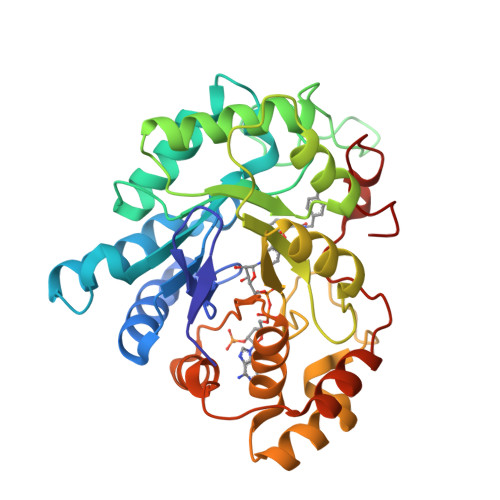Modulation of aldose reductase inhibition by halogen bond tuning.
Fanfrlik, J., Kolar, M., Kamlar, M., Hurny, D., Ruiz, F.X., Cousido-Siah, A., Mitschler, A., Rezac, J., Munusamy, E., Lepsik, M., Matejicek, P., Vesely, J., Podjarny, A., Hobza, P.(2013) ACS Chem Biol 8: 2484-2492
- PubMed: 23988122
- DOI: https://doi.org/10.1021/cb400526n
- Primary Citation of Related Structures:
4LAU, 4LAZ, 4LB3, 4LB4, 4LBR, 4LBS - PubMed Abstract:
In this paper, we studied a designed series of aldose reductase (AR) inhibitors. The series was derived from a known AR binder, which had previously been shown to form a halogen bond between its bromine atom and the oxygen atom of the Thr-113 side chain of AR. In the series, the strength of the halogen bond was modulated by two factors, namely bromine-iodine substitution and the fluorination of the aromatic ring in several positions. The role of the single halogen bond in AR-ligand binding was elucidated by advanced binding free energy calculations involving the semiempirical quantum chemical Hamiltonian. The results were complemented with ultrahigh-resolution X-ray crystallography and IC50 measurements. All of the AR inhibitors studied were shown by X-ray crystallography to bind in an identical manner. Further, it was demonstrated that it was possible to decrease the IC50 value by about 1 order of magnitude by tuning the strength of the halogen bond by a monoatomic substitution. The calculations revealed that the protein-ligand interaction energy increased upon the substitution of iodine for bromine or upon the addition of electron-withdrawing fluorine atoms to the ring. However, the effect on the binding affinity was found to be more complex due to the change of the solvation/desolvation properties within the ligand series. The study shows that it is possible to modulate the strength of a halogen bond in a protein-ligand complex as was designed based on the previous studies of low-molecular-weight complexes.
Organizational Affiliation:
Institute of Organic Chemistry and Biochemistry and Gilead Science Research Center, Academy of Sciences of the Czech Republic , Flemingovo nam. 2, 166 10 Prague 6, Czech Republic.


















